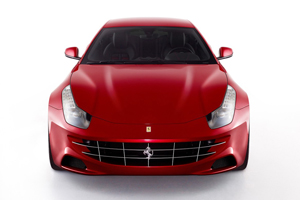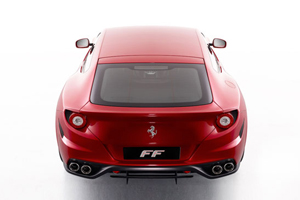The Ferrari of Station Wagons
The four-seat Ferrari 612 Scaglietti is a great car, but not our favorite Ferrari. Launched in 2004, it’s getting long in the tooth, and the curvaceous body, lacking in tension, never really grew on us.
At this year’s Geneva auto show, Maranello will debut a Scaglietti successor that is not only visually exciting in a way the 612 never managed, but departs from the Ferrari gospel in two tremendous ways: It’s the first all-wheel-drive prancing horse, and it’s a two-door station wagon, or shooting brake.
Say What?!
The Pininfarina-styled four-seater folds futuristic shapes and detailing into classic front-engine proportions. The front end is dominated by a hood and headlights that are inspired by the 458 Italia, while the greenhouse sits far aft and flows into to a rear end with recessed taillights and a low tailgate. It is long (193.2 inches), wide (76.9 inches), and relatively low (54.3 inches), and to our eyes, it is absolutely stunning. The FF, says Ferrari, seats four comfortably and offers ample space for luggage.

The FF moniker stands for "Ferrari Four" in reference to the fact that all four of the wheels are driven. Ferrari claims that its all-wheel-drive system, called 4RM, is 50 percent lighter than comparable systems, but provides no details on how this was achieved. (RM stands for ruote motrici, so 4RM just means “four-wheel-drive” in Italian.) Regardless, the Italians have managed to keep total weight down to 3,946 pounds, no small feat given the size and power of the car. (The last 612 Scaglietti we tested was nearly 200 pounds heavier, at 4,123.)
Fifty-seven percent of that weight is perched over the rear axle. Curiously, British manufacturer Jensen built a four-seat, all-wheel-drive supercar by the name of FF in the late Sixties. The acronym then stood for Ferguson Formula, Harry Ferguson Research being the supplier of its all-wheel drive system.
Business as Usual
The shape and drivetrain layout may be unusual, but the engine is pure Ferrari: a 6.3-liter, naturally aspirated 65-degree V-12 that produces 651 hp at a screaming 8,000 rpm and 504 lb-ft of torque at 6,000. The power is channeled through a dual-clutch transmission and performance, as you would expect, should be extraordinary. Ferrari claims that zero to 60 mph will take just 3.7 seconds—we suspect that is a highly conservative guess—and top speed will be a lofty 208 mph. Magnetorheological shocks will help the FF handle, and Brembo carbon-ceramic brakes will halt it. Fuel efficiency is rated at 15.3 mpg in the European combined cycle, which is invariably more optimistic than the EPA cycles in the U.S. So don’t expect the FF to be the green Ferrari we’ve been expecting.
 2012 Ferrari FF
2012 Ferrari FFFerrari history is peppered with Shooting Brake conversions. At the Turin auto show in 1968, coachbuilder Vignale unveiled the 330 Special. A few years later, Panther created a shooting brake based on the 365 GTB/4 Daytona. Swiss coachbuilder Felber got in on the fun with its 365 GTC/4 “Break,” introduced at in Geneva in 1977, and followed that a few years later with a conversion of the Ferrari 400 called Croisette. And, in the mid-’90s, Pininfarina built a few four-door station wagons based on the Ferrari 456 for the Sultan of Brunei. From the looks of it, though, the FF is getting the history of the official Ferrari shooting brake off to a spectacular start.
Source: autos.yahoo.com



0 comments:
Post a Comment